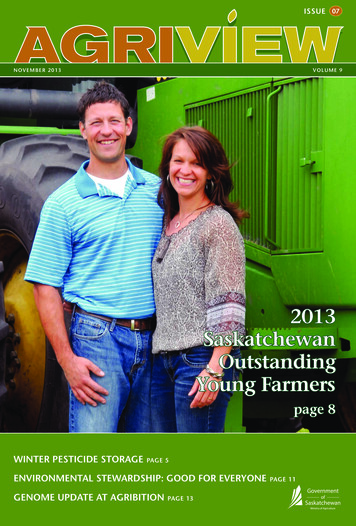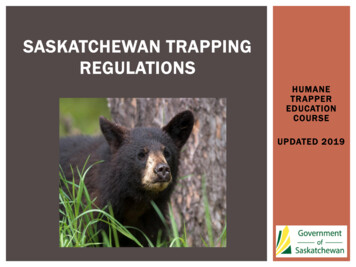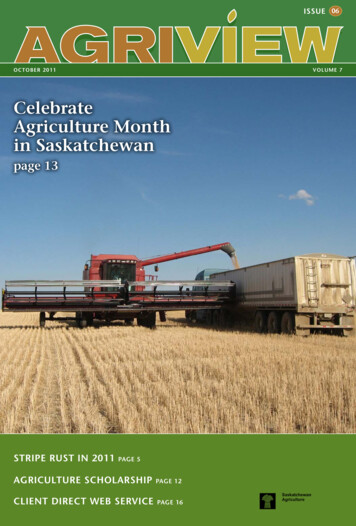
Transcription
07November 2013VOLUME 92013SaskatchewanOutstandingYoung Farmerspage 8winter pesticide storagepage 5environmental stewardship: good for everyoneGenome update at Agribitionpage 13page 11
Minister’s MessageThe growing season has now come to an end with many producers harvesting a bumpercrop. Yields and quality were at a level many of us have never experienced before. Whilewe were fortunate with weather and timely rains, the credit should first and foremostgo to our producers.Saskatchewan’s farmers and ranchers are recognized nationally and internationally as leadersin the agriculture industry. Producers are quick to adapt to new technologies and practicesthat help increase production and help drive Saskatchewan’s growth. I want to commendeveryone who contributes to Saskatchewan’s agriculture industry. It is through yourcommitment that Saskatchewan will continue to increase our agri-food production andexports, contributing to a stronger future.It is important that we take the time to recognize those who are leaders in our industry. In this issue of Agriview,you will read about Chad and Darlene Krikau of Stream Stick Farms Ltd., from Waldheim. Chad and Darlene werenamed as the 2013 Saskatchewan Outstanding Young Farmers in June. This November, they will join six otherNational Finalists from across Canada to compete for Canada’s Outstanding Young Farmers at an event held duringAgribition. As further proof of Saskatchewan’s leadership in the agriculture industry, since the inception of thenational awards in 1982, 10 of the National Winners have come from Saskatchewan; more than any other province.I wish the best of luck to Chad and Darlene as they represent Saskatchewan, but I also want to thank all ourproducers who do a tremendous job year-in and year-out.As a vibrant industry with endless career opportunities, it is important that we encourage our youth to considera career in agriculture. We need strong leaders who are passionate and will continue to grow the industry wellinto the future. In October, I had the opportunity to once again announce the Saskatchewan Agriculture StudentScholarship. This year, we will award one winning scholarship of 4,000 and three runner-up scholarships valuedat 2,000. I would encourage students who are pursuing a career in agriculture to apply for the scholarship.The Canadian Western Agribition is another example of Saskatchewan’s leadership in the agriculture industry.Recognized as one of the best livestock shows in North America, Agribition was named the 2012 SaskatchewanEvent of the Year. This year’s show will take place from November 11 to 16 and is an excellent opportunity tonetwork and learn about emerging trends and practices in the livestock and farming industries.In closing, I would like to once again thank all the leaders of our industry. Agriculture truly is the driver of oureconomy and an industry of opportunity – and it is because of the vision and dedication of everyone involvedthat it will continue to be in the future.Sincerely,Lyle Stewart
STORY SNAPSHOTS12134Saskatchewan Ag Student ScholarshipStacking round balesproperly62013 SIPA/ICDC conferenceLivestock Traceability Rebate ProgramTABLE OF CONTENTSCropsAgriculture AwarenessResearch07november 2013810volume 9LivestockPrograms And Services2013SaskatchewanOutstandingYoung FarmersEvents Calendarpage 8winter pesticide storage4page 7environmental stewardship: good for everyonegenome update at agribitionpage 11page 13Cover: Chad and Darlene Krikau are therecipients of the 2013 SaskatchewanOutstanding Young Farmers Award. Forinformation on the Outstanding Young FarmersProgram, turn to page eight.AGRIVIEW is published by the Communications Branch of Saskatchewan Agriculture for Saskatchewan farmers,ranchers and farm and food organizations. For more information, call 306-787-5160 or email agriview@gov.sk.ca.To view this publication online, visit www.agriculture.gov.sk.ca/programs-services.111316
CROPSAre you an AGvocate? Tell us your story towin the Agriculture Student Scholarship!by Krystal Aulie, B.CommProvincial Business Management Specialist, HR and YouthRegional Services BranchAgriculture is the foundation of opportunity in Saskatchewan.The options are endless for young people looking to start acareer in the industry—from production, research and processingto manufacturing, finance and everything in between. In fact, onein eight Canadian jobs are in agriculture and agri-food.The Saskatchewan Ministry of Agriculture offers the AgricultureStudent Scholarship, which awards one winning scholarship valued at 4,000 and three runner-up scholarships valued at 2,000 to studentswilling to speak up and tell the story of agriculture.In order to qualify for the scholarship, you must be a SaskatchewanGrade 12 student or recent high school graduate who is planning topursue an agriculture-related post-secondary education. To apply, youare required to produce a three-minute creative video or write awell-researched 1,000-word essay that showcases agriculture in one ofthe following themes: solutions for a growing world, stewardshiptowards tomorrow, safe food that is responsibly produced and futureforward agriculture industry.Applicants will also be required to submit a letter of reference from ateacher, agriculture industry member or community leader and proofof enrollment in an agriculture-related post-secondary program.Applications will be accepted until March 1, 2014. Visit theSaskatchewan Agriculture website for more information on how toapply. Winning submissions will be featured on the Ministry’s website.This is the fourth annual Agriculture Student Scholarship. Last year, 10,000 was awarded to Saskatchewan students who submittedapplications explaining why agriculture, now more than ever, is avibrant, diverse industry. Past winners have pursued agriculture-relatededucation at the University of Saskatchewan, Lakeland College andother post-secondary institutions.So what are you waiting for? Encourage the young people in your lifeto become an agricultural advocate and apply for this scholarship.For more information Contact Krystal Aulie, Provincial Business Management Specialist,at 306-798-0947 or krystal.aulie@gov.sk.ca; or Visit www.agriculture.gov.sk.ca/scholarship.Volunteer rainfall observers wantedby Spencer SmitSaskatchewan Provincial CoordinatorCoCoRaHS CanadaCFor more information, or to sign up to CoCoRaHS Email saskatchewan@cocorahs.org; Call 1-855-999-8858; or Apply directly through the website at www.cocorahs.org/canada.oCoRaHS, short for Community Collaborative Rain, Hail andSnow network, is an international precipitation-monitoringprogram with more than 100 observers in Manitoba andSaskatchewan, and several thousand in the United States.CoCoRaHS Saskatchewan is urgently looking for volunteers. With thepublic’s help, they hope to provide timely and accurate rain, hail andsnow measurement data from across the province in order to providethe highest quality data for emergency response, educational,agricultural and research applications.CoCoRaHS is a non-profit, grass-roots volunteer network ofweather enthusiasts of all ages and backgrounds. CoCoRaHSoriginated at Colorado State University. It has been implementedsuccessfully in all 50 U.S. states and has significant sponsorship bygovernment and private organizations.Each observer takes daily readings and enters them through theprogram website, www.cocorahs.org/canada. Most volunteers havea very easy time getting started and learn everything they need toknow from the simple online tutorials on the website. Along with thetraining, CoCoRaHS provides observers with a monitoring kit thatincludes an official CoCoRaHS rain gauge, a heavy-duty snowmeasuring stick and a snow paddle. Volunteers pay 30 for the kit,a price that has been subsidized by the program sponsors. Each day,when they can, volunteer observers input their measurementsthrough the website, which are then available to the general publicthrough an interactive map. If the volunteers miss a day of observing,there are also multi-day reports available.4NOVEMBER 2013
CROPSAdd your voice to Canada’s varietyregistration forumby Danielle StephensCrops Agrologist InternAgriculture Knowledge CentreCanada’s variety registration system for crops is currently underreview. Earlier this year the federal Agriculture Minister requestedthat the crop variety recommending committees review their currentprocedures and propose ways to make the process of varietyregistration more efficient.Concurrently with that review, Agriculture and Agri-Food Canada,the Canadian Food Inspection Agency and the Canadian GrainCommission have put together an options paper that describes thecurrent crop variety registration system and outlines three otheroptions which Canada could adopt going forward.This options paper can be found online at www.agr.gc.ca/CropVR.It gives a good background on Canada’s current registration system:how it is structured, what crops are in which category, the testing ofthe crops required in each category and how the criteria or “merit”of the crop characteristics are judged.Merit means new varieties should be as good or better than areference or “check” variety in terms of specific characteristics, suchas yield. Although not every variety will surpass previous varieties inall characteristics, the purpose of merit is to ensure that new varietiesrepresent a general improvement over current varieties or still fallwithin the range of other varieties used as “checks” before they willbe recommended as varieties. Merit testing does not apply to all croptypes, but is currently used in wheat, canola and most other majorcrops in Saskatchewan.How does Canada’s variety registration move forward? There are fouroptions that the paper presents for discussion:1. Allow current flexibilities built into the variety registration systemto mature;2. Have all crops meet a minimum registration requirement, andhave some crops go through independent merit assessment;3. Have all crops meet a minimum registration requirement, but nothave a merit assessment attached to variety registration for any crops;4. Have the federal government withdraw its role in oversight ofvariety registration.There is a questionnaire on the website that allows you to weigh inon what you think the process should look like. You can talkgenerally or specifically to your crop of interest/involvement. Thereview is looking for the viewpoints of stakeholders: those who growcrops, buyers and sellers of grain and end users of crops. Thisquestionnaire will be available until November 30.For more information Visit www.agr.gc.ca/CropVR and click on the link to theOptions Paper and Crop Variety Registration in Canada Questionnaire.Safe overwinter storage of pesticidesby Erin Campbell, PAgRegional Crops Specialist, WatrousRegional Services BranchAfter spraying is done for the season, it is important to ensure thatpesticides are properly stored over the winter months. Thefollowing are a few reminders about proper storage conditions.Storage and ultimately the disposal of unwanted or obsolete pesticidesmust be done in a safe and responsible way as specified on the productlabel. Clean Farms is a national organization sponsored by pesticidemanufacturers to provide pesticide container recycling and disposalservices. Clean Farms (www.cleanfarms.ca) runs a program that willcollect unwanted or obsolete pesticides from the farm.For more information Contact the Agriculture Knowledge Centre at 1-866-457-2377.Pesticides should always be stored in their original containers toprevent contamination or misuse of the pesticides. Products must bestored safely away from children, pets and animals and should not bestored near food, open flames or other volatile products that maycause hazardous reactions. Pesticides must be stored in a secure,heated (i.e. will not freeze over the winter months), dry room. Thestorage temperature should not be overly warm since high heat canaccelerate the degradation of the pesticide components and cause therisk of fire. Storage rooms must be properly ventilated to the outsideto prevent buildup of hazardous, flammable or explosive fumes.Allowing pesticide products to freeze can cause numerous problems.Some pesticide products expand when frozen, damaging the containersand causing them to leak. Freezing may cause some pesticides to settleout of the mixture, resulting in the pesticide formulation separatinginto its various chemical components. This can affect the performanceof the pesticide. The product label will indicate whether the pesticidecan be used after freezing, and will include instructions on proceduresrequired for the pesticide to be effectively used in the future. Forexample, if settling has occurred, many products recommend that thecontainer be allowed to warm to room temperature and then gentlyagitated to reconstitute the product.Pesticides must be dealt with in a safe, environmentally responsible way.NOVEMBER 20135
CROPSIrrigated crop rotations: a riskmanagement strategyby Gary Kruger, Irrigation AgrologistAgronomy ServicesCrops and Irrigation BranchHow can an irrigator reduce disease and insect risks with goodcrop rotation?The general agronomic principle is to keep disease, insects and weedsoff guard by alternating crop type from cereal to broadleaf eachsubsequent year. Including a second cereal and broadleaf crop,preferably of an earlier or later crop maturity, in this alternating cycledevelops a simple four-year rotation. Fababean, dry bean or field peacan be grown as a pulse in the irrigated rotation.Crop rotation will lessen disease risk only for those infections spreadby plant residue or soil contamination. Diseases differ in the range ofcrops they affect. Some diseases are limited to one or two crops whileothers affect all crops of one type (for example, sclerotinia forbroadleaved plants). Adequate soil fertility aids healthier growth andreduces the likelihood of disease.There are things irrigators cannot control by rotation, such as diseaseand insects that blow into the area on prevailing southerly winds.Examples include leaf hoppers that spread aster yellows, leaf, stemand stripe rusts and diamondback moths. There are also thingsirrigators can positively affect by rotation like diseases such assclerotinia in oilseeds and pulse crops, blackleg in canola, root rots,ergot, leaf diseases and fusarium head blight on cereals and leafdiseases in pulse crops. Other examples of rotational benefits includesynergistic factors such as beneficial mycorrhizae fungal populationsand herbicide-resistant weeds.Forages help control crop diseases. Crop rotation’s benefit is difficult toexpress in dollars and cents because the benefit is mainly reduced risk.So what can irrigators do to develop a good rotation?1) Learn the life cycles of the diseases and insects that affect their crops.2) Learn about crop agronomy benefits and issues for crops. Forexample, flax grows better following cereals versus following canola.3) Understand the factors of herbicide resistance that increase itsrisk. Incorporate strategies into the rotation to lessen this risk.4) Talk with an agrologist.For more information Contact Gary Kruger at 306-867-5524 or gary.kruger@gov.sk.ca.2013 SIPA/ICDC Annual Conferenceby Garth Weiterman, ManagerAgronomy ServicesCrops and Irrigation BranchandJeff Ewen, Irrigation AgrologistAgronomy ServicesCrops and Irrigation BranchOn December 3 and 4, the Irrigation Crop DiversificationCorporation (ICDC) and the Saskatchewan Irrigation ProjectsAssociation (SIPA) are holding their annual conference and generalmeetings in Moose Jaw at the Temple Gardens Mineral Spa.This year’s banquet speaker is Professor Chandra Madramootoo, Deanof the College of Agriculture and Environmental Sciences at McGillUniversity in Montreal. Professor Madramootoo has built a verystrongly funded research program covering various aspects of waterresources management and soil and water engineering. He has beenproject leader on many large-scale water and environmental researchprojects in Canada and the world.The 2013 SIPA conference will feature presentations from suppliers onnew high sprinkler and pivot technology for efficient food productionand to increase water efficiencies. Our business meeting will include:highlights of 2013; a funded infrastructure program available to allirrigators, discussion on irrigation strategy for Saskatchewan, status ofthe federal southwest irrigation projects divestiture and theQu’Appelle South Irrigation District Inc.; as the final report on the6potential water conveyance project from Lake Diefenbaker to BuffaloPound Lake; and, a report on the completion of the study “Highvolume vegetable production in Saskatchewan”.In 2013, the ICDC program featured cereal fertility trials, irrigationscheduling using innovative monitoring technology and the use offungicides on cereals, flax and canola. The forage program includedsalt-tolerant alfalfa, fertilizer applications to alfalfa stands, annualcereals for forage production and nitrogen rates for oats grown onland that had previously been sown to alfalfa. Speakers will bepresenting their results during the day.The ICDC is a non-profit corporation funded by a levy from districtirrigators. It is an Agriculture-Applied Research Management (AgriARM) site with support from the Ministry of Agriculture. ICDC’smandate is to ensure farmer-directed irrigation research,demonstration and extension programs are in place to supportSaskatchewan’s irrigators.SIPA is a non-profit corporation representing the interests of theirrigation industry in Saskatchewan. SIPA is funded throughvoluntary producer levies and industry sponsorships. It is dedicatedto the expansion of irrigation in Saskatchewan and is committed topromoting the benefits of irrigation to all citizens for the province’sgrowth and economic well-being, now and in the future.For more information Visit www.irrigationsaskatchewan.com; or Contact Garth Weiterman at 306-867-5528 orgarth.weiterman@gov.sk.ca.NOVEMBER 2013
CROPSKnow your long-term frost-freegrowing windowby Lyndon Hicks, PAgRegional Crops Specialist, YorktonRegional Services BranchKnowing the long-term dates for the last spring frost and firstfall frost is very important in order to make accurate croppingdecisions. Often our short-term memorytakes over and we remember the recentyears where the first fall frost has beenmuch later than usual. When makingcropping decisions, producers should relyupon hard data rather than memories.Cool soil temperatures are needed to keepthe nitrogen in the ammonium form. Thisprotects it from denitrification during thespring when melting snow and rain canlead to high nitrogen losses. In the soil,urea and anhydrous ammonia convertquickly to ammonium that has a positivecharge. These positively charged moleculesattach themselves securely to thenegatively charged soil and soil organicmatter particles, significantlyminimizing losses.Many Saskatchewan producers areexperimenting with non-traditional crops,thanks to new technology, new varietiesand new grain markets, as well as thenewly discovered agronomic benefits ofthese crops. These crops may be new to the province or just new tothe region. Either way, being aware of the frost-free growing windowfor the area is important.Most crop varieties have specific days-to-maturity ratings. Theseratings are measured from seeding date to swathing readiness.However, the actual number of days to reach maturity depends uponlocal weather conditions and, to some extent, management practices.Using the regional average last spring frost and first fall frost dates tocalculate the typical number of frost-free growing days is a basic stepin making informed cropping decisions.Producers should also keep in mind the impact of the frost-free dayson their crop insurance coverage. To be insurable, any seeded crop isexpected to reach a reasonable level of maturitybefore the first fall frost date in an area. Thefinal seeding dates on which liability will beaccepted are general and reflect the latest datethe crop could be seeded, based on the area’slatest average first fall frost. If a crop is seededby the final date that liability is accepted, butwas seeded too late to be reasonably expectedto mature, liability may be reduced or denied.The Saskatchewan Crop Insurance Corporation(SCIC) encourages producers to contact theirlocal SCIC office if they have questions aboutthe seeding deadlines for insurable crops.The Ministry of Agriculture has maps that willprovide producers with long-term average frostdates for the province. These dates are averagesbut, combined with a producer’s knowledge ofthe local area, are a very useful tool.For a larger version of the ‘First Fall Frost’ mapor to view the ‘Last Spring Frost’ map, refer towww.saskcropinsurance.com/cropinsurance/maps.For more information Contact the Regional Crops Specialist in the nearest SaskatchewanAgriculture Regional Office; or Call the Agriculture Knowledge Centre at 1-866-457-2377.Prairie Fresh Food Corporation is growingby Connie Achtymichuk, PAgProvincial Specialist, VegetablesCrops and Irrigation BranchThe March issue of Agriview featured a story about vegetableproducers in the province forming a value chain to grow thelarger volumes of produce required by retailers. The producers dividedthe province into geographic zones, and worked co-operatively toproduce radishes, carrots, baby carrots,cauliflower, beets, baby beets, green andyellow beans, pickling cucumbers, dill,garlic, zucchini and sweet corn for TheGrocery People, a subsidiary of FederatedCo‑operatives Limited. These vegetables wereshipped to the warehouse in Saskatoon andthen distributed to co-op food storesthroughout the province.In April of this year, 16 of those producers formed the Prairie FreshFood Corporation, and elected a board of directors. They confirmedwhich zones were producing which products and coordinatedplanting and harvest dates to ensure that sufficient quantities wereavailable throughout the season.NOVEMBER 2013The corporation ordered packaging with the Home GrownSaskatchewan brand. Grade standards were put in place andworkshops held to ensure that the specifications were understood.Then, after waiting for the snow to melt, it was full steam ahead withplanting, weeding, harvesting and shipping.It was an amazing summer for the Prairie Fresh Food Corporation. TheGrocery People and Federated Co-op treated them very well, not onlyby providing the market, or the reason to grow, but also by creatingawareness of the product and the corporation.Their No Garden, No Problem advertisingcampaigns were appreciated by the growers.This year, Prairie Fresh Food Corporation wasa group of 16, but the members expect thecorporation will grow in 2014, as moreproducers grow more acres and moreproducts. This is just the beginning of theretail produce industry in Saskatchewan.For more information Contact Connie Achtymichuk at 306-787-2755 orconnie.achtymichuk@gov.sk.ca.7
AgRiculture AwarenessRecognizing Canada’s OutstandingYoung FarmersCanada’s Outstanding Young Farmers program is in its 33rd year ofrecognizing farmers who exemplify excellence in their professionand promote the tremendous contribution of agriculture. Theprogram is open to farm operators between the ages of 18 and 39 whoderive a minimum of two-thirds of their income from farming. Eachyear, one farming couple is selected from a group of nominees fromeach of the program’s seven Regional Recognition Events. The couplethen represents their respective region at the National RecognitionEvent, which this year is being held in Regina in conjunction withCanadian Western Agribition, November 11 to 16.At the national event, the seven honourees are recognized for theirachievements and judged by a distinguished panel of judges using thefollowing criteria: Progress made during their farming career; Maximum utilization of soil, water and energy conservationpractices; Crop and livestock production history; Financial and management practices; and Contributions to the well-being of the community, provinceand nation.Every year, two of the seven honourees are chosen by the judges as Canada’s Outstanding Young Farmers.Saskatchewan Outstanding Young Farmers profilesWinnerChad and Darlene KrikauStream Stick Farms Ltd., WaldheimChad and Darlene Krikau were named Saskatchewan’sOutstanding Young Farmers at Canada’s Farm Progress Show inRegina on June 21. Now they are in the running for the title ofCanada’s Outstanding Young Farmers, which will be awarded atCanadian Western Agribition.The Krikaus, with their two children, Liam and Kalyna, own andoperate Stream Stick Farms Ltd., a 2,630-acre grain farm located inWaldheim. Both Chad and Darlenecame from farming families but theyhadn’t started their careers asfull-time farmers. Chad was anagrologist with a local agriculturalconsultancy and working some landthat he had rented from his father,while Darlene taught high school.The Krikaus’ lives changed one dayin 2005. Chad was working with oneof his clients, Elmer Enns, who waslooking for some harvest help. Chadhad admired the progressiveapproach that Enns and his partner,Jim Flath, were taking to agriculture.As an agrologist, he worked with alot of farmers, and he could see thatthe partners’ willingness to adoptthe latest technology was bearingfruit. So he offered to help.That was the beginning of a friendship that allowed Chad andDarlene to expand their own land base, secure in the knowledgethat they had access to the equipment necessary to farm it. Whilethe farms were separate entities, the partners shared equipment andlabour. Stream Stick Farms was 530 acres in 2007. It doubled in sizein 2009 and was 1,650 acres in 2011.But while they had land, they weren’t quite a farm family in thatthey still lived in town. That changed in 2012 when a nearby elderlyfarmer decided to retire. He approached Enns because he admiredEnns’ farming ability. He also wanted a young couple to take overthe farmstead he and his wife had carefully tended over theirlifetimes, and he knew of Enns’ relationship with the Krikaus.8So Chad and Darlene got the farmstead they had so long dreamedabout, and the partners split the land between themselves. StreamStick Farms grew to 2,630 acres, and the partners’ combined landbase totaled 9,000 acres.Now that they have the farm they have always dreamed of, they aredetermined to make it financially profitable and environmentallyhealthy. They are canny marketers and eager adopters of newtechnology and crop varieties that offer economic andenvironmental benefits.This year, the Krikaus experimentedwith early maturing soybeans in thehope of adding it to their regular croprotation. They also picked soybeansbecause of its marketing potential.“Soybeans have many uses,” Chadexplains, “and in our opinion aren’tsubject to macro-changes in the marketlike some of the other smaller-volumecrops grown in Saskatchewan.”They grow genetically modified canolabecause of its environmental benefits.“GMO canola has allowed us to usefewer chemicals and less fuel,” he says.“We also use less tillage than we didbefore, which has reduced soil erosionon our fields.”When not busy on the farm, Chad and Darlene are active supportersof Agriculture in the Classroom and Harvest 4 Kids, teaching cityyouth about agriculture and where their food comes from. They arealso very active in their community, coaching minor league hockeyand soccer, and volunteering their services in other ways to theircommunity and church.“Being named Saskatchewan’s Outstanding Young Farmer of 2013has been a very humbling experience,” says Darlene. “Thisopportunity has further expanded our network of peers who areinnovative and forward-thinking, and represent many facets of theagricultural industry. We look forward to attending the nationalevent at Agribition and to participating in future OYF events.”NOVEMBER 2013
AgRiculture AwarenessFinalistsKristjan and Theresa HebertHebert Grain Ventures, MoosominHebert Grain Ventures, a grain and oilseed farm in Moosomin, Saskatchewan, is owned and operated by Kristjan andTheresa Hebert and their child, Bentley. Kristjan began his farming career at the age of 15, renting his first land. By theage of 17, he had 500 acres and a custom spraying business. Today, the Heberts crop 7,800 acres. Zero-till, shallowtillage, soil testing and grid sampling are some examples of what the Heberts are using today to ensure anenvironmentally friendly approach to farming while producing the best possible crops on their land. Besides beingbusy with the farm, Kristjan can be found chairing or advising on a couple of industry boards, or in the local hockeyarena. Theresa can be found caring for their young son, or preparing meals for the men working in the fields, or withher horses. She is involved with numerous horse societies and associations in the province and competes at many localhorse shows. The Heberts are also active in their church and support many community functions.Brennan and Cara WiensWiens Seed Farm. HerschelBrennan and Cara Wiens, with their three children, Mitchell, Carmen and Adam, own and operate a 4,300-acrecustom cereal and pulse pedigree operation at Herschel, Saskatchewan. Brennan and Cara, not completely satisfiedwith their city careers after their graduation from university, decided to come back to the familiar roots of farmingon their family farm. They believe increasing soil health by direct seeding and continuous cropping and/orchemfallowing are paramount when looking at the long-term success of their farm. When not reading or attendingeducational seminars, the Wiens can be found volunteering in their church or their community.Tyler and Pamela SmithSmith Northern Ranching, Duck LakeTyler and Pamela Smith, with their children, Walker and Jacy, run a cow/calf, backgrounding and grain operation inDuc
2013 SIPA/ICDC conference Cover: Chad and Darlene Krikau are the recipients of the 2013 Saskatchewan Outstanding Young Farmers Award. For information on the Outstanding Young Farmers . Lakeland College and other post-secondary institutions. So what are you waiting for? Encourage the young people in your life










